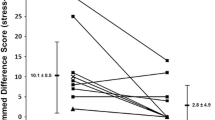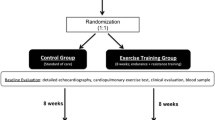Abstract
Purpose
Percutaneous transluminal coronary angioplasty (PTCA) is one of the main therapy options for patients with coronary artery disease (CAD), resulting in an improvement in myocardial perfusion and exercise capacity. Nevertheless, studies have also demonstrated a positive effect of regular exercise training on myocardial perfusion and maximum exercise capacity. The aim of this study was to evaluate changes in myocardial stress perfusion after 1 year of exercise training in comparison with the effects of PTCA in patients with CAD.
Methods
In 66 male patients with angiographically confirmed significant coronary artery stenosis in one target vessel, myocardial perfusion scintigraphy was performed at baseline and 12 months after randomisation into either a physical exercise group or a PTCA group. Circumferential count rate profiles in 16 wall segments were classified according to their relative count rate and localisation within or outside the area supplied by the stenosed vessel.
Results
Ischaemic segments showed a significant improvement in myocardial count rate within the target area after 12 months in both the PTCA and the training group (PTCA group: from 76.8±4.9% to 86.6±10.9%, p=0.03; training group: from 74.0±7.3% to 83.7±10.8%, p<0.01). Outside the target area only the training group showed a significant improvement (from 77.7±4.4% to 91.7±4.8%, p<0.01).
Conclusion
Our data indicate a significant improvement in stress myocardial perfusion in the training group after 12 months. The ischaemia is reduced not only in the target region of the leading stenosis but also in other ischaemic myocardial areas. In contrast, after PTCA stress perfusion improves only in the initially ischaemic parts of the target area.


Similar content being viewed by others
References
Hueb WA, Bellotti G, De Oliveira SA, Arie S, de Albuquerque CP, Jatene AD, et al. The medicine, angioplasty or surgery study (MASS): a prospective, randomized trial of medical therapy, balloon angioplasty or bypass surgery for single proximal left anterior descending artery stenosis. J Am Coll Cardiol 1995;26:1600–5.
Parisi AF, Folland ED, Hartingan P. A comparison of angioplasty with medical therapy in the treatment of single-vessel coronary artery disease. Veterans Affairs ACME Investigators. N Engl J Med 1992;326:10–6.
Strauss WE, Fortin T, Hartigan P, Folland ED, Parisi AF. A comparison of quality of life scores in patients with angina pectoris after angioplasty compared with after medical therapy. Outcomes of a randomised clinical trial. The Veterans Affair Study of Angioplasty Compared to Medical Therapy Investigators. Circulation 1995;92:1710–9.
Randomised trial of cholesterol lowering in 4444 patients with coronary heart disease: the Scandinavian Simvastatin Survival Study (4S). Lancet 1994;344:1383–9.
Sacks FM, Pfeffer MA, Moye LA, Rouleau JL, Rutherford JD, Cole TG, et al. The effect of pravastatin on coronary events after myocardial infarction in patients with average cholesterol levels. Cholesterol and Recurrent Events Trial Investigators. N Engl J Med 1996;335:1001–9.
Pitt B, Waters D, Brown WV, van Boven AJ, Schwartz L, Title LM, et al. Aggressive lipid-lowering therapy compared with angioplasty in stable coronary artery disease. N Engl J Med 1999;341:70–6.
Schuler G, Schlierf G, Wirth A, Mautner HP, Scheurlen H, Thumm M, et al. Low-fat diet and regular, supervised physical exercise in patients with symptomatic coronary artery disease: reduction of stress-induced myocardial ischemia. Circulation 1988;77:172–81.
Schuler G, Hambrecht R, Schlierf G, Grunze M, Methfessel S, Hauer K, et al. Myocardial perfusion and regression of coronary artery disease in patients on a regimen of intensive physical exercise and low fat diet. J Am Coll Cardiol 1992;19:34–42.
Schuler G, Hambrecht R, Schlierf G, Niebaurer J, Hauer K, Newmann J, et al. Regular physical exercise and low-fat diet. Effects on progression of coronary artery disease. Circulation 1992;86:1–11.
Gobel FL, Norstrom LA, Nelson RR, Jorgensen CR, Wang Y. The rate–pressure product as an index of myocardial oxygen consumption during exercise in patients with angina pectoris. Circulation 1978;57:549–56.
Iskandrian AS, Heo J, Kong B, Lyons E. Effect of exercise level on the ability of thallium-201 tomographic imaging in detecting coronary artery disease: analysis of 461 patients. J Am Coll Cardiol 1989;14:1477–86.
Kluge R, Sattler B, Seese A, Knapp WH. Attenuation correction by simultaneous emission–transmission myocardial single-photon emission tomography using a technetium-99m-labelled radiotracer: impact on diagnostic accuracy. Eur J Nucl Med 1997;24:1107–14.
Ficaro EP, Fessler JA, Shreve PD, Kritzman JN, Rose PA, Corbett JR. Simultaneous transmission/emission myocardial perfusion tomography: diagnostic accuracy of attenuation-corrected 99mTc-sestamibi single-photon emission computed tomography. Circulation 1996;93:463–73.
Hambrecht R, Walther C, Mobius-Winkler S, Gielen S, Linke A, Conradi K, et al. Percutaneous coronary angioplasty compared with exercise training in patients with stable coronary artery disease: a randomized trial. Circulation 2004;109:1371–8.
Gensini GG. A more meaningful scoring system for determining the severity of coronary heart disease. Am J Cardiol 1983;51:606.
Hirzel HO, Nuesch K, Gruentzig AR, Luetolf UM. Short and long term changes in myocardial perfusion after percutaneous transluminal coronary angioplasty assessed by thallium-201 exercise scintigraphy. Circulation 1981;63:1001–7.
Beniamini Y, Rubenstein JJ, Zaichkowsky LD, Crim MC. Effects of high-intensity strength training on quality-of-life parameters in cardiac rehabilitation patients. Am J Cardiol 1997;80:841–6.
Clausen JP, Larsen OA, Trap-Jensen J. Physical training in the management of coronary artery disease. Circulation 1969;40:143–54.
Froelicher V, Jensen D, Genter F, Sullivan M, McKirnan MD, Witztum K, et al. A randomized trial of exercise training in patients with coronary heart disease. JAMA 1984;252:1291–7.
Kennedy CC, Spiekerman RE, Lindsay MI Jr, Mankin HT, Frye RL, McCallister BD. One-year graduated exercise program for men with angina pectoris. Evaluation by physiologic studies and coronary arteriography. Mayo Clin Proc 1976;51:231–6.
Ornish D, Scherwitz LW, Billings JH, Brown SE, Gould KL, Merritt TA, et al. Intensive lifestyle changes for reversal coronary heart disease. JAMA 1998:280:2001–7.
Hambrecht R, Niebauer J, Marburger C, Grunze M, Kalberer B, Hauer K, et al. Various intensities of leisure time physical activity in patients with coronary artery disease. Effects on cardiorespiratory fitness and progression of coronary atherosclerotic lesions. J Am Coll Cardiol 1993;22:468–77.
Haskell WL, Alderman EL, Fair JM, Maron DJ, Mackey SF, Superko HR, et al. Effects of intensive multiple risk factor reduction on coronary atherosclerosis and clinical cardiac events in men and women with coronary artery disease. The Stanford Coronary Risk Intervention Project (SCRIP). 1994;89:975–90.
Cohen MV, Yipintsoi T, Scheuer T. Coronary collateral stimulation by exercise in dogs with stenotic coronary arteries. J Appl Physiol 1982;52:664–71.
Scheel KW, Ingram LA, Wilson JL. Effects of exercise on the coronary and collateral vasculature of beagles with and without coronary occlusion. Circ Res 1981;48:523–30.
Fergusson RJ, Petitclerc R, Choquette G, Chaniotis L, Gauthier L, Huot R, et al. Effects of physical training on treadmill exercise capacity, collateral circulation and progression of coronary artery disease. Am J Cardiol 1974;34:764–9.
Belardinelli R, Georgiou D, Ginzton L, Cianci G, Purcaro A. Effects of moderate exercise training on thallium uptake and contractile response to low-dose dobutamine of dysfunctional myocardium in patients with ischemic cardiomyopathy. Circulation 1998;97:553–61.
Ernst E. Influence of regular physical activity on blood rheology. Eur Heart J 1987;Suppl. G:59–62.
Reinhart WH, Dziekan G, Goebbels U, Myers J, Dubach P. Influence of exercise training on blood viscosity in patients with coronary artery disease and impaired left ventricular function. Am Heart J 1998;135:379–82.
Hambrecht R, Wolf A, Gielen S, Linke A, Hofer J, Erbs S, et al. Effect of exercise on coronary endothelial function in patients with coronary artery disease. N Engl J Med 2000;342:454–60.
Hosokawa S, Hiasa Y, Takahashi T, Itoh S. Effect of regular exercise on coronary endothelial function in patients with recent myocardial infarction. Circ J 2003;67:221–4.
Altehoefer C, vom Dahl J, Messmer BJ, Hanrath P, Bull U. Fate of the resisting perfusion defect as assessed with technetium-99m-methoxy-isobutyl-isonitrile single-photon emission computed tomography after successful revascularisation in patients with healed myocardial infarction. Am J Cardiol 1996;77:88–92.
Liu P, Kiess MC, Okada RD, Block PC, Strauss HW, Pohost GM, et al. The persistent defect on exercise thallium imaging and its fate after myocardial revascularisation: does it present scar or ischemia? Am Heart J 1985;110:996–1001.
Lucignani G, Paolini G, Landoni C, Zuccari M, Paganelli G, Galli L, et al. Presurgical identification of hibernating myocardium by combined use of technetium-99m-hexakis-2-methoxyisobutylisonitrile single photon emission tomography and fluorine-18-fluoro-2-deoxy-d-glucose positron emission tomography in patients with coronary artery disease. Eur J Nucl Med 1992;19:874–81.
Raff W, Sialer G, von Segesser L, Pfeiffer A, Turina M, Schulthess GK. Perioperative myocardial perfusion scintigraphy at rest with technetium-99m-methoxyisobutylisonitrile before and after coronary bypass operations. Eur J Nucl Med 1991;18:99–105.
vom Dahl J, Altehoefer C, Sheehan FH, Buechin P, Uebis R, Messmer BJ, et al. Recovery of regional left ventricular dysfunction after coronary revascularization. Impact of myocardial viability assessed by nuclear imaging and vessel patency at follow-up angiography. J Am Coll Cardiol 1996;28:948–58.
Acknowledgement
We would like to thank Amersham Buchler GmbH & Co. KG, General Electric Healthcare for the financial support in the publication of this study.
Author information
Authors and Affiliations
Corresponding author
Rights and permissions
About this article
Cite this article
Kendziorra, K., Walther, C., Foerster, M. et al. Changes in myocardial perfusion due to physical exercise in patients with stable coronary artery disease. Eur J Nucl Med Mol Imaging 32, 813–819 (2005). https://doi.org/10.1007/s00259-005-1768-1
Received:
Accepted:
Published:
Issue Date:
DOI: https://doi.org/10.1007/s00259-005-1768-1




